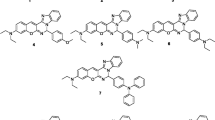Abstract
We systematically investigate, at density functional theory level, the electronic properties of a set of ten carotenoid molecules with different conjugation length. Ground state geometries were fully optimized using both B3LYP and its long-range corrected version, i.e., the CAM-B3LYP functional. The time-dependent DFT approach (TD-DFT) was also performed for the calculation of the excited states of the optimized geometries and the results were compared to the experimental ones, when available. Our findings indicate a dependence of the transition vertical energies, oscillator strengths, and transition dipole moments on the extension of conjugation, as expected. We also investigate the impact of the intra-molecular vibrations on the absorption spectrum by means of the Franck–Condon (FC) and nuclear ensemble (NE) approach to spectra simulation. Our simulations suggest that the Franck–Condon approximation may not be suitable to appropriately characterize the vibronic progression of these molecules, whereas the NE approach provides a contribution that vary from negligible to meaningful depending on which molecule and energy region is under analysis.







Similar content being viewed by others
References
Fu Y-T, da Silva Filho DA, Sini G, Asiri AM, Aziz SG, Risko C, Brédas J-L (2014) Adv Funct Mater 24:3790–3798
Gunes S, Neugebauer H, Sariciftci NS (2007) Chem Rev 107:1324–1338
Wang X-F, Wang L, Wang Z, Wang Y, Tamai N, Hong Z, Kido J (2013) J Phys Chem C 117:804–811
da Silva Prado A, Leal LA, de Brito PP, de Almeida Fonseca AL, Blawid S, Ceschin AM, Mourão RHV, da Silva Júnior AQ, da Silva Filho DA, Junior LAR, da Cunha WF (2017) J Mol Model 23:196/1–9
Tange R, Inai K, Sagawa T, Yoshikawa S (2011) J Mater Res 26:306–310
Britton G, Liaaen-Jensen S, Pfander H (2004) carotenoids: Handbook
Ribeiro LA, da Cunha WF, Neto PHO, Gargano R, Silva GM (2013) New J Chem 37:2829–2836
Kjelstrup-Hansen J, Norton JE, da Silva Filho DA, Brédas J-L, Rubahn H-G (2009) Org Electr 10:1228–1234
Balakina MYu, Li J, Geskin VM, Marder SR, Brédas JL (2000) J Chem Phys 113:9598–9609
Lee CT, Yang WT, Parr RG (1988) Phys Rev B 37:785–789
Becke AD (1988) Phys Rev A 38:3098–3100
Becke AD (1993) J Chem Phys 98:5648–5652
Yanai T, Tew D, Handy N (2004) Chem Phys Lett 393:51–57
Crespo-Otero R, Barbatti M (2012) Theor Chem Acc 131:1237
Francl MM, Pietro WJ, Hehre WJ, Binkley JS, Gordon MS, Defrees DJ, Pople JA (1982) J Chem Phys 77:3654–3665
Hariharan PC, Pople JA (1973) Theor Chim Acta 28:213–222
Martins JBL, Durães JA, Sales MJA, Vilela AFA, Silva GM, Gargano R (2009) Int J Quantum Chem 109:739–745
Kjelstrup-Hansen J, Norton JE, da Silva Filho DA, Brédas JL, Rubahn HG (2009) Org Electron 10:1228–1234
Frisch MJ, Trucks GW, Schlegel HB, Scuseria GE, Robb MA, Cheeseman JR, Scalmani G, Barone V, Mennucci B, Petersson GA, Nakatsuji H, Caricato M, Li X, Hratchian HP, Izmaylov AF, Bloino J, Zheng G, Sonnenberg JL, Hada M, Ehara M, Toyota K, Fukuda R, Hasegawa J, Ishida M, Nakajima T, Honda Y, Kitao O, Nakai H, Vreven T, Montgomery Jr JA, Peralta JE, Ogliaro F, Bearpark M, Heyd JJ, Brothers E, Kudin KN, Staroverov VN, Kobayashi R, Normand J, Raghavachari K, Rendell A, Burant JC, Iyengar SS, Tomasi J, Cossi M, Rega N, Millam JM, Klene M, Knox JE, Cross JB, Bakken V, Adamo C, Jaramillo J, Gomperts R, Stratmann RE, Yazyev O, Austin AJ, Cammi R, Pomelli C, Ochterski JW, Martin RL, Morokuma K, Zakrzewski VG, Voth GA, Salvador P, Dannenberg JJ, Dapprich S, Daniels AD, Farkas Ö, Foresman JB, Ortiz JV, Cioslowski J, Fox DJ (2009) Gaussian 09 revision d.01. Gaussian Inc , Wallingford
Barbatti M, Ruckenbauer M, Plasser F, Pittner J, Granucci G, Persico M, Lischka H (2014) WIREs Comput Mol Sci 4:26–33
Lima IT, Prado A, da S, Martins JBL, de Oliveira Neto PH, Ceschin AM, da Cunha WF, da Silva Filho DA (2016) J Phys Chem A 120:4944–4950
Rodriguez-Amaya DB (2001) A guide to carotenoid analysis in foods. International Life Sciences Institute Press, Washington
Rodriguez-Amaya DB, Kimura M (2004) Harvestplus handbook for carotenoid analysis. International Food Policy Research Institute, Washington
Craft NE, Soares Jr JH (1992) J Agric Food Chem 40:431–434
Macpherson AN, Gillbro T (1998) J Phys Chem A 102:5049–5058
Billsten HH, Zigmantas D, Sundstrom V, Polivka T (2002) Chem Phys Lett 355:465–470
Acknowledgements
The authors gratefully acknowledge the financial support from Brazilian Research Councils CNPq, CAPES, FAP-DF, and FINATEC and CENAPAD-SP for providing the computational facilities. D.A.S.F. gratefully acknowledges the financial support from the Brazilian Research Council CNPq, grants 407682/2013-9 and 304020/2016-8, and FAP-DF grants 193.001.284/2016 and 0193.001.062/2015. L.A.R.J gratefully acknowledges the financial support from the Brazilian Research Council FAP-DF grant 0193.000942/2015. The authors R.T.S.J. and L.A.R.J. wish to thank the Brazilian Ministry of Planning, Budget and Management (Grant DIPLA 005/2016).
Author information
Authors and Affiliations
Corresponding author
Additional information
This paper belongs to Topical Collection VI Symposium on Electronic Structure and Molecular Dynamics – VI SeedMol
Electronic supplementary material
Below is the link to the electronic supplementary material.
Rights and permissions
About this article
Cite this article
Lima, I.T., Sousa, L., Freitas, R.d.S. et al. A DFT study of a set of natural dyes for organic electronics. J Mol Model 23, 343 (2017). https://doi.org/10.1007/s00894-017-3512-8
Received:
Accepted:
Published:
DOI: https://doi.org/10.1007/s00894-017-3512-8




